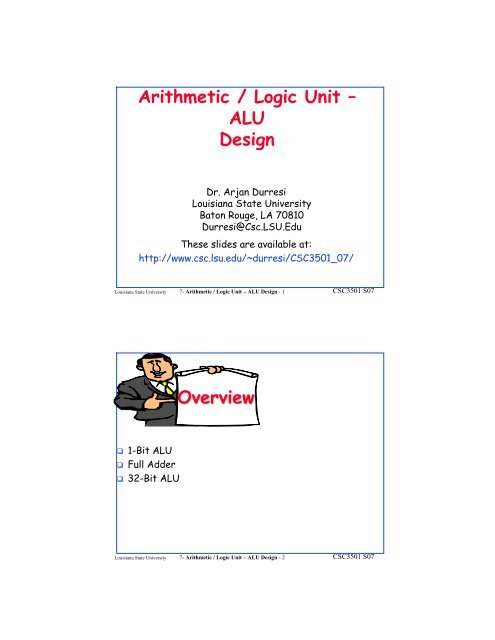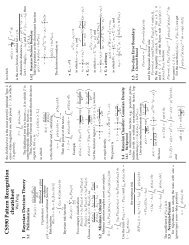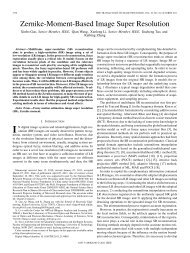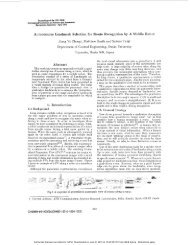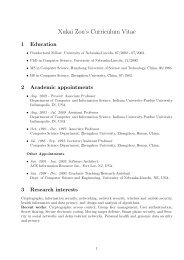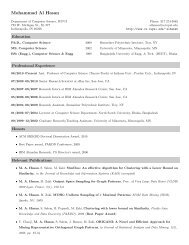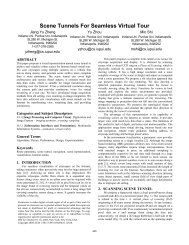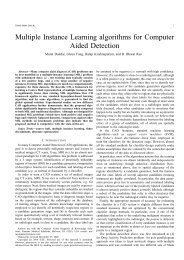Arithmetic / Logic Unit ? ALU Design Overview
Arithmetic / Logic Unit ? ALU Design Overview
Arithmetic / Logic Unit ? ALU Design Overview
Create successful ePaper yourself
Turn your PDF publications into a flip-book with our unique Google optimized e-Paper software.
<strong>Arithmetic</strong> / <strong>Logic</strong> <strong>Unit</strong> –<br />
<strong>ALU</strong><br />
<strong>Design</strong><br />
Dr. Arjan Durresi<br />
Louisiana State University<br />
Baton Rouge, LA 70810<br />
Durresi@Csc.LSU.Edu<br />
These slides are available at:<br />
http://www.csc.lsu.edu/~durresi/CSC3501_07/<br />
Louisiana State University 7- <strong>Arithmetic</strong> / <strong>Logic</strong> <strong>Unit</strong> – <strong>ALU</strong> <strong>Design</strong> -1<br />
1-Bit <strong>ALU</strong><br />
Full Adder<br />
32-Bit <strong>ALU</strong><br />
<strong>Overview</strong><br />
Louisiana State University 7- <strong>Arithmetic</strong> / <strong>Logic</strong> <strong>Unit</strong> – <strong>ALU</strong> <strong>Design</strong> -2<br />
CSC3501 S07<br />
CSC3501 S07
Different Implementations<br />
Not easy to decide the “best” way to build something<br />
Don't want too many inputs to a single gate<br />
Don’t want to have to go through too many gates<br />
for our purposes, ease of comprehension is important<br />
Let's look at a 1-bit <strong>ALU</strong> for addition:<br />
a<br />
b<br />
CarryIn<br />
CarryOut<br />
How could we build a 1-bit <strong>ALU</strong> for add, and, and or?<br />
How could we build a 32-bit <strong>ALU</strong>?<br />
Louisiana State University 7- <strong>Arithmetic</strong> / <strong>Logic</strong> <strong>Unit</strong> – <strong>ALU</strong> <strong>Design</strong> -3<br />
Sum<br />
c out = a b + a c in + b c in<br />
sum = a xor b xor c in<br />
32-bit <strong>ALU</strong><br />
Our <strong>ALU</strong> should be able to perform functions:<br />
logical and function<br />
logical or function<br />
arithmetic add function<br />
arithmetic subtract function<br />
arithmetic slt (set-less-then) function<br />
logical nor function<br />
Louisiana State University 7- <strong>Arithmetic</strong> / <strong>Logic</strong> <strong>Unit</strong> – <strong>ALU</strong> <strong>Design</strong> -4<br />
CSC3501 S07<br />
<strong>ALU</strong> control lines define a function to be performed on A and B.<br />
CSC3501 S07
A 1-Bit <strong>ALU</strong><br />
The 1-bit logical unit for AND and OR<br />
Louisiana State University 7- <strong>Arithmetic</strong> / <strong>Logic</strong> <strong>Unit</strong> – <strong>ALU</strong> <strong>Design</strong> -5<br />
A Full Adder<br />
Louisiana State University 7- <strong>Arithmetic</strong> / <strong>Logic</strong> <strong>Unit</strong> – <strong>ALU</strong> <strong>Design</strong> -6<br />
CSC3501 S07<br />
CSC3501 S07
A Full Adder<br />
CarryOut=( b*CarryIn)+( a*CarryIn)+( a*b)+(a*b*CarryIn)<br />
CarryOut=( b*CarryIn)+( a*CarryIn)+( a*b)<br />
Louisiana State University 7- <strong>Arithmetic</strong> / <strong>Logic</strong> <strong>Unit</strong> – <strong>ALU</strong> <strong>Design</strong> -7<br />
A Full Adder<br />
Louisiana State University 7- <strong>Arithmetic</strong> / <strong>Logic</strong> <strong>Unit</strong> – <strong>ALU</strong> <strong>Design</strong> -8<br />
CSC3501 S07<br />
Sum=(a⋅b⋅CarryIn)+(a⋅b⋅CarryIn)+(a⋅b⋅CarryIn)+(a⋅b⋅CarryIn)<br />
CSC3501 S07
Functioning of 32-bit <strong>ALU</strong><br />
Result lines provide result of the chosen function applied to<br />
values of A and B Since this <strong>ALU</strong> operates on 32-bit operands, it<br />
is called 32-bit <strong>ALU</strong><br />
Zero output indicates if all Result lines have value 0<br />
Overflow indicates a sign integer overflow of add and subtract<br />
functions; for unsigned integers, this overflow indicator does not<br />
provide any useful information<br />
Carry out indicates carry out and unsigned integer overflow<br />
Louisiana State University 7- <strong>Arithmetic</strong> / <strong>Logic</strong> <strong>Unit</strong> – <strong>ALU</strong> <strong>Design</strong> -9<br />
CSC3501 S07<br />
<strong>Design</strong>ing 32-bit <strong>ALU</strong>: Beginning<br />
Louisiana State University 7- <strong>Arithmetic</strong> / <strong>Logic</strong> <strong>Unit</strong> – <strong>ALU</strong> <strong>Design</strong> -10<br />
CSC3501 S07
<strong>Design</strong>ing 32-bit <strong>ALU</strong>: Principles<br />
Louisiana State University 7- <strong>Arithmetic</strong> / <strong>Logic</strong> <strong>Unit</strong> – <strong>ALU</strong> <strong>Design</strong> -11<br />
32-bit Adder<br />
Louisiana State University 7- <strong>Arithmetic</strong> / <strong>Logic</strong> <strong>Unit</strong> – <strong>ALU</strong> <strong>Design</strong> -12<br />
CSC3501 S07<br />
This is a ripple carry adder.<br />
The key to speeding up addition<br />
is determining carry out in the<br />
higher order bits sooner.<br />
Result: Carry look-ahead<br />
adder.<br />
CSC3501 S07
32-bit <strong>ALU</strong> With 3 Functions<br />
Louisiana State University 7- <strong>Arithmetic</strong> / <strong>Logic</strong> <strong>Unit</strong> – <strong>ALU</strong> <strong>Design</strong> -13<br />
CarryOut<br />
32-bit Subtractor<br />
Louisiana State University 7- <strong>Arithmetic</strong> / <strong>Logic</strong> <strong>Unit</strong> – <strong>ALU</strong> <strong>Design</strong> -14<br />
CSC3501 S07<br />
CSC3501 S07
32-bit Adder / Subtractor<br />
Louisiana State University 7- <strong>Arithmetic</strong> / <strong>Logic</strong> <strong>Unit</strong> – <strong>ALU</strong> <strong>Design</strong> -15<br />
CSC3501 S07<br />
32-bit <strong>ALU</strong> With 4 Functions<br />
Louisiana State University 7- <strong>Arithmetic</strong> / <strong>Logic</strong> <strong>Unit</strong> – <strong>ALU</strong> <strong>Design</strong> -16<br />
CSC3501 S07
2’s Complement Overflow<br />
Louisiana State University 7- <strong>Arithmetic</strong> / <strong>Logic</strong> <strong>Unit</strong> – <strong>ALU</strong> <strong>Design</strong> -17<br />
CSC3501 S07<br />
32-bit <strong>ALU</strong> With 4 Functions<br />
and Overflow<br />
Louisiana State University 7- <strong>Arithmetic</strong> / <strong>Logic</strong> <strong>Unit</strong> – <strong>ALU</strong> <strong>Design</strong> -18<br />
CSC3501 S07
Set Less Than (slt) Function<br />
Louisiana State University 7- <strong>Arithmetic</strong> / <strong>Logic</strong> <strong>Unit</strong> – <strong>ALU</strong> <strong>Design</strong> -19<br />
CSC3501 S07<br />
32-bit <strong>ALU</strong> With 5 Functions<br />
Louisiana State University 7- <strong>Arithmetic</strong> / <strong>Logic</strong> <strong>Unit</strong> – <strong>ALU</strong> <strong>Design</strong> -20<br />
CSC3501 S07
A – B = 0 ⇒ A = B<br />
To test fore Zero:<br />
Zero<br />
Zero = (Result31+Result30+ . . . Result2+ Result1+ Result0)<br />
Louisiana State University 7- <strong>Arithmetic</strong> / <strong>Logic</strong> <strong>Unit</strong> – <strong>ALU</strong> <strong>Design</strong> -21<br />
CSC3501 S07<br />
32-bit <strong>ALU</strong> with 5 Functions<br />
and Zero<br />
Louisiana State University 7- <strong>Arithmetic</strong> / <strong>Logic</strong> <strong>Unit</strong> – <strong>ALU</strong> <strong>Design</strong> -22<br />
CSC3501 S07
Faster Addition: Carry Lookahead<br />
The key to speeding up addition is determining the<br />
carry in to the high-order bits sooner.<br />
Fast Carry Using “Infinite” Hardware<br />
CarryIn2 = (b1⋅CarryIn1)+(a1⋅CarryIn1)+ (a1⋅b1)<br />
CarryIn1=(b0⋅CarryIn0)+(a0⋅CarryIn0)+ (a0⋅b0)<br />
And<br />
C2=(a1⋅a0⋅b0)+(a1⋅a0⋅c0)+(a1⋅b0⋅c0) +<br />
+(b1⋅a0⋅b0)+(b1⋅a0⋅c0)+(b1⋅b0⋅c0)+(a1⋅b1)<br />
Louisiana State University 7- <strong>Arithmetic</strong> / <strong>Logic</strong> <strong>Unit</strong> – <strong>ALU</strong> <strong>Design</strong> -23<br />
Carry-lookahead Adder<br />
ci+1 = (bi⋅ci) + (ai⋅ci) + (ai⋅bi) =<br />
= (ai⋅bi) + (ai+ bi) ⋅ ci<br />
Generate (gi) and propagate (pi)<br />
gi = ai ⋅ bi<br />
pi = ai + bi<br />
ci+1 = gi + pi ⋅ ci<br />
If gi = 1. That is, the adder generates a CarryOut (ci+1)<br />
independent of the value of CarryIn (ci)<br />
ci+1 = gi + pi ⋅ ci = 1<br />
If gi = 0 and pi = 1<br />
ci+1 = gi + pi ⋅ ci = 0 + 1 ⋅ ci = ci<br />
The adder propagates CarryIn to a CarryOut.<br />
Louisiana State University 7- <strong>Arithmetic</strong> / <strong>Logic</strong> <strong>Unit</strong> – <strong>ALU</strong> <strong>Design</strong> -24<br />
CSC3501 S07<br />
CarryIni+1 is a 1 if either gi is 1 or both pi is 1 and CarryIni is 1.<br />
CSC3501 S07
Carry-lookahead Adder<br />
Louisiana State University 7- <strong>Arithmetic</strong> / <strong>Logic</strong> <strong>Unit</strong> – <strong>ALU</strong> <strong>Design</strong> -25<br />
Carry-lookahead Adder<br />
A plumbing analogy for<br />
carry lookahead for 1<br />
bit, 2 bits, and 4 bits<br />
using water pipes and<br />
valves.<br />
Louisiana State University 7- <strong>Arithmetic</strong> / <strong>Logic</strong> <strong>Unit</strong> – <strong>ALU</strong> <strong>Design</strong> -26<br />
CSC3501 S07<br />
CSC3501 S07
Fast Carry Using the Second<br />
Level of Abstraction<br />
To go faster, we’ll need carry lookahead at a higher level.<br />
For the four 4-bit adder blocks:<br />
That is, the “super” propagate signal for the 4-bit abstraction<br />
(Pi) is true only if each of the bits in the group will propagate a<br />
carry.<br />
Louisiana State University 7- <strong>Arithmetic</strong> / <strong>Logic</strong> <strong>Unit</strong> – <strong>ALU</strong> <strong>Design</strong> -27<br />
CSC3501 S07<br />
Fast Carry Using the Second<br />
Level of Abstraction<br />
For the “super” generate signal (Gi), we care only if there is a<br />
carry out of the most significant bit of the 4-bit group.<br />
This obviously occurs if generate is true for that most<br />
significant bit; it also occurs if an earlier generate is true and all<br />
the intermediate propagates, including that of the most<br />
significant bit, are also true:<br />
Louisiana State University 7- <strong>Arithmetic</strong> / <strong>Logic</strong> <strong>Unit</strong> – <strong>ALU</strong> <strong>Design</strong> -28<br />
CSC3501 S07
Fast Carry Using the Second<br />
Level of Abstraction<br />
A plumbing analogy for the nextlevel<br />
carry-lookahead signals P0<br />
and G0.<br />
P0 is open only if all four<br />
propagates (pi) are open, while<br />
water flows in G0 only if at least<br />
one generate (gi) is open and all<br />
the propagates downstream from<br />
that generate are open.<br />
Louisiana State University 7- <strong>Arithmetic</strong> / <strong>Logic</strong> <strong>Unit</strong> – <strong>ALU</strong> <strong>Design</strong> -29<br />
CSC3501 S07<br />
Example: Speed of Ripple Carry<br />
versus Carry Lookahead<br />
Time is estimated by simply counting the number of gates along<br />
the path through a piece of logic. Compare the number of gate<br />
delays for paths of two 16-bit adders, one using ripple carry and<br />
one using two-level carry lookahead.<br />
the carry out signal takes two gate delays per bit. Then the<br />
number of gate delays between a carry in to the least significant<br />
bit and the carry out of the most significant is 16 × 2 = 32.<br />
Louisiana State University 7- <strong>Arithmetic</strong> / <strong>Logic</strong> <strong>Unit</strong> – <strong>ALU</strong> <strong>Design</strong> -30<br />
CSC3501 S07
Example<br />
For carry lookahead, the carry out of the most<br />
significant bit is just C4, defined in the example. It<br />
takes two levels of logic to specify C4 in terms of Pi<br />
and Gi (the OR of several AND terms). Pi is specified<br />
in one level of logic (AND) using pi, and Gi is specified<br />
in two levels using pi and gi, so the worst case for this<br />
next level of abstraction is two levels of logic. pi and<br />
gi are each one level of logic, defined in terms of ai<br />
and bi. If we assume one gate delay for each level of<br />
logic in these equations, the worst case is 2 + 2 + 1 = 5<br />
gate delays.<br />
Louisiana State University 7- <strong>Arithmetic</strong> / <strong>Logic</strong> <strong>Unit</strong> – <strong>ALU</strong> <strong>Design</strong> -31<br />
NOR<br />
Louisiana State University 7- <strong>Arithmetic</strong> / <strong>Logic</strong> <strong>Unit</strong> – <strong>ALU</strong> <strong>Design</strong> -32<br />
CSC3501 S07<br />
CSC3501 S07
32-bit <strong>ALU</strong> with 6 Functions<br />
Louisiana State University 7- <strong>Arithmetic</strong> / <strong>Logic</strong> <strong>Unit</strong> – <strong>ALU</strong> <strong>Design</strong> -33<br />
32-bit <strong>ALU</strong> Elaboration<br />
Louisiana State University 7- <strong>Arithmetic</strong> / <strong>Logic</strong> <strong>Unit</strong> – <strong>ALU</strong> <strong>Design</strong> -34<br />
CSC3501 S07<br />
We have now accounted for all but one of the<br />
arithmetic and logic functions for the core MIPS<br />
instruction set. 32-bit <strong>ALU</strong> with 6 functions omits<br />
support for shift instructions.<br />
It would be possible to widen 1-bit <strong>ALU</strong> multiplexer to<br />
include 1-bit shift left and/or 1-bit shift right.<br />
Hardware designers created the circuit called a barrel<br />
shifter, which can shift from 1 to 31 bits in no more<br />
time than it takes to add two 32-bit numbers. Thus,<br />
shifting is normally done outside the <strong>ALU</strong>.<br />
CSC3501 S07
1-Bit <strong>ALU</strong><br />
Full Adder<br />
32-Bit <strong>ALU</strong><br />
Summary<br />
Louisiana State University 7- <strong>Arithmetic</strong> / <strong>Logic</strong> <strong>Unit</strong> – <strong>ALU</strong> <strong>Design</strong> -35<br />
CSC3501 S07


